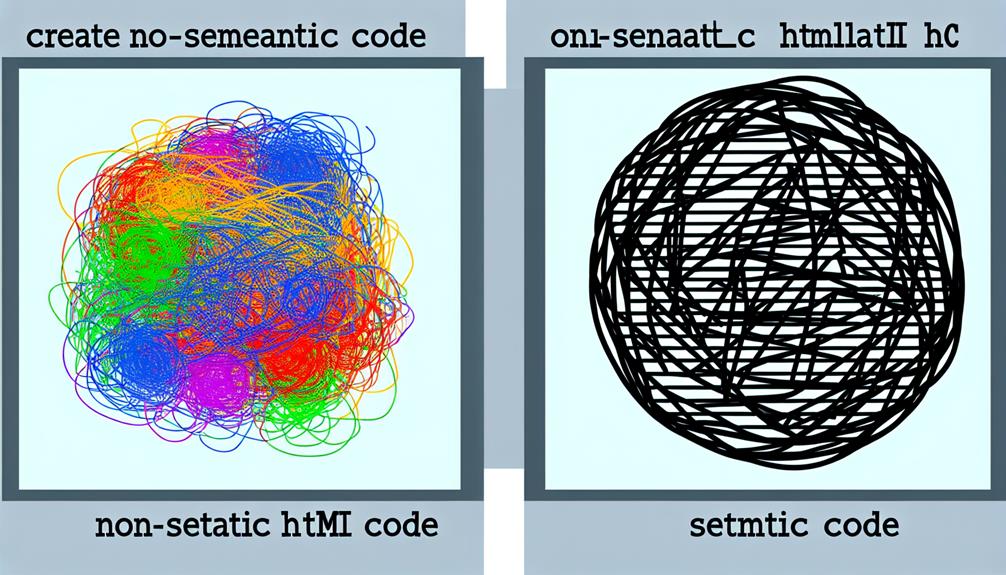To boost your SEO, leveraging semantic HTML tags is key. Tags like `<header>`, `<nav>`, and `<footer>` structure your content, making it understandable for search engines. This effective indexing improves your website visibility and search rankings, as Google prioritizes semantic HTML. Use `<header>` for your site title, `<nav>` for hierarchy, and `<footer>` for contact info. Slip your main content into `<main>` and use `<article>` for individual posts. Remember, SEO isn't all about keywords—it's also about creating structure search engines can grasp. Ready to dominate those search results? Let's explore more strategies.
Key Takeaways
- Use semantic HTML elements like `<header>`, `<nav>`, and `<footer>` to provide structure and improve search engine indexing.
- Enclosing main content in `<main>` and using `<article>` for posts can enhance visibility on search engines.
- Strategic implementation of semantic HTML tags can improve site readability and accessibility, boosting SEO performance.
- Semantic HTML aids in efficient indexing and categorization of web content, enhancing visibility and SEO ranking.
- Services like SEO.co offer tools for semantic HTML optimization to boost search engine rankings and increase organic traffic.
Understanding Semantic HTML
To fully leverage the power of SEO, you'll need to grasp the concept of Semantic HTML and how its proper use can greatly enhance your website's visibility and ranking. Semantic HTML, a key tool in web development, provides structure and meaning to web content. It does this through the use of semantic elements like <header>, <nav>, <main>, <aside>, and <footer>, each serving a unique role in the webpage layout.
These semantic elements play a vital role in categorizing and indexing your web content accurately. They create a well-organized webpage layout, enhancing visibility and subsequently, your search engine ranking. It's a strategic move to incorporate these elements as search engines, like Google, consider semantic HTML as a ranking factor. Misusing or ignoring these elements can impact your SEO performance.
Semantic elements also aid in the interpretation of your web content. They help search engines understand the context and relevance of your content. This understanding improves the indexing of your site and the accuracy of search results, ensuring your content reaches its intended audience.
Evolution of Semantic HTML
As you've seen, semantic HTML plays a crucial role in enhancing SEO performance, and over time, it's developed to include tags such as <article>, <section>, <header>, and <footer> that further emphasize structured and meaningful content. This evolution has been essential in aiding search engines understand the context and relevance of webpages.
This progress in semantic HTML has brought about significant changes in the way content is presented and understood. Structured content not only provides a better user experience but also impacts how search engines perceive your website. Here are a few advancements that have been made:
- The introduction of tags like <article>, <section>, <header>, and <footer> allows for a more organized layout of your content.
- The use of these tags helps search engines decipher the structure of your website, making it easier to understand the context of your webpage.
- The relevance of your content is improved, leading to better visibility and higher rankings in search results.
The strategic use of semantic HTML has revolutionized the way search engines index and rank websites. The more comprehensible your content is to search engines, the better your indexing and visibility will be. This is where the significance of your content comes into play. Search engines are more likely to rank a webpage higher if the content is relevant to a user's search query.
The evolution of semantic HTML has, therefore, been a game-changer, offering a more systematic approach to presenting content and improving the interaction between websites and search engines. It's an integral part of your SEO strategy that you can't afford to overlook.
Website Crawling and Semantic HTML

Understanding how website crawling works can give you an advantage in SEO, and it's here that the role of semantic HTML becomes crucial. Website crawling is the process where search engine bots methodically browse the web to index information for use in search. Semantic HTML directly influences this process, directing these bots through your site's structure and content hierarchy.
Semantic HTML elements such as <article>, <section>, and <nav> are essential in providing a clear structure to your website. These tags offer valuable insights to search engine bots, allowing them to categorize and interpret your content accurately. This, in turn, improves your site's visibility and ranking in search results.
Consider the semantic tags <header> and <footer>. These aren't just aesthetic choices but strategic elements that contribute to enhanced crawling efficiency and indexing accuracy. By utilizing these, you're creating a roadmap for the bots, streamlining their process and ensuring your content gets the attention it deserves.
But it isn't just about making life easy for search engine bots. Semantic HTML also adds significance to your content. It helps emphasize the importance of different content sections, enabling more precise indexing. The more precisely your site is indexed, the more likely it's to rank high on search engines, leading to improved SEO.
Importance of Accessibility With Semantic HTML
Often ignored, semantic HTML not only optimizes your site for search engines, but it's also crucial for enhancing your website's accessibility, particularly for assistive technologies like screen readers. By providing a clear structure to your content, you're enabling these technologies to interpret your site more accurately and efficiently.
Semantic HTML tags like `<nav>` for navigation bars and `<header>` for headings are essential for screen readers. They rely on these tags to understand the website structure and the relationship between different parts of your content. This allows visually impaired users to navigate your site and comprehend the content more easily.
Consider the difference that these elements make:
- Imagine a table of contents with clear headings and subheadings in a book. That's what a properly structured website feels like for visually impaired users using screen readers.
- Picture a well-organized library where books are sorted by genre, author, and title. That's how a website with effective semantic HTML appears to assistive technologies.
- Think about an efficient customer service system that directs you to the right department without any confusion. That's the level of user experience you can provide by using semantic HTML.
These visual references reflect how proper use of semantic HTML can greatly enhance accessibility and user experience. It promotes equal access to information, ensuring that all visitors, including those with disabilities, can navigate your website with ease.
Semantic HTML in SEO Strategies

Incorporating semantic HTML in your SEO strategies can significantly enhance your website's visibility, search engine ranking, and overall performance. This is because semantic tags are a fundamental part of Semantic HTML for SEO. They provide structure and context to your web content, making it easier for search engines to categorize and index accurately.
When you use semantic tags in your HTML code, you're basically providing clear, meaning-driven markers that guide search engine algorithms in understanding your content's relevance and context. This is an important aspect of search engine optimization (SEO) as it directly impacts how your website appears on search engine results pages (SERPs).
Google, for instance, considers semantic markup as a ranking factor. This means web developers who effectively use semantic HTML elements such as <header>, <nav>, <main>, <aside>, and <footer> in their SEO strategy are likely to enjoy enhanced visibility and ranking. This is because these tags not only contribute to a well-structured webpage layout but also help search engines understand the content better.
In essence, semantic HTML is more than just about code cleanliness. It's a strategic approach to improving your SEO performance. By integrating semantic HTML elements into your web content, you're creating a roadmap that leads search engines straight to the most relevant parts of your site.
Overview of Semantic HTML Elements
Now, let's explore the world of semantic HTML elements, a fundamental tool you can use to structure and enhance your web content for SEO. These elements are significant because they bring structure and meaning to your web content. They're not just about making your site look good, but also about helping search engines like Google understand and categorize the information on your pages more efficiently.
Semantic HTML elements include tags like `<header>`, `<nav>`, `<main>`, `<aside>`, and `<footer>`. These elements don't just serve aesthetic purposes, but they:
- Define the layout of your web page, helping browsers and search engines understand your content's structure
- Aid in categorizing and indexing your content accurately
- Make your web page layout SEO-friendly, enhancing your website's visibility and search engine ranking
Remember, Google considers semantic HTML as a ranking factor. This means the better you use semantic HTML elements, the higher the possibility of your website ranking higher in search results. This is pivotal in today's digitally-driven world where online visibility can make or break your business.
In essence, the strategic use of semantic HTML elements is a powerful way to make your web content more accessible, user-friendly, and SEO-friendly. It's all about creating a solid structure and imbuing meaning into your content, making it easier for Google to read, understand, and rank your site. This is the art and science of semantic HTML. It's more than just code; it's a strategic approach to boosting your SEO.
Implementing Semantic HTML Tips

To enhance your website's SEO performance, it's crucial to incorporate semantic HTML elements such as `<header>`, `<nav>`, and `<footer>` which offer a clear structure and meaning to your web content.
The `<header>` tag marks the top of your webpage, often containing the site title and primary navigation links. `<nav>` is utilized for the navigation segment, assisting search engines in comprehending your site's hierarchy. The `<footer>` typically includes details like contact information, copyright statements, and extra navigation links.
Your main content should be enclosed in a `<main>` tag. This is vital for search engines as it identifies the main content on your webpage. This tag improves the understanding of the page layout by search engines, helping in more precise indexing and ultimately boosting your SEO ranking.
Another SEO best practice is utilizing the `<article>` tag for individual posts or content sections. This tag aids search engines in distinguishing between different content pieces, leading to improved indexing.
Lastly, consider the `<aside>` tag for content associated with your main content but not integrated within it, such as sidebars or pull quotes. This contributes to the overall organization of your webpage, enhancing the clarity of your site structure for both users and search engines.
Benefits of Semantic HTML for Website Structure
By implementing Semantic HTML in your website structure, you're not only enhancing accessibility for users but also assisting web crawlers in understanding your content.
This strategic move guarantees your website is future-proof, as search engines evolve to prioritize semantic understanding.
Let's explore the benefits of this approach and how it can greatly boost your SEO performance.
Enhancing User Accessibility
In utilizing Semantic HTML, you're not only creating a well-structured website layout and boosting SEO, but also greatly enhancing user accessibility. This is particularly beneficial to users with visual impairments who depend on screen readers to navigate the web.
Semantic HTML provides meaning and context to your web content. By using semantic tags like <header>, <nav>, and <footer>, you're defining the different areas of your website, making it easier for users to understand and navigate.
Consider these key advantages:
- Semantic tags provide a clear content hierarchy, making your website more intuitive and navigable.
- Screen readers use semantic tags to interpret and process the content, enhancing the user experience for those with visual impairments.
- Structured content with semantic tags contributes to better website accessibility, ensuring all users have equal access to your content.
The strategic application of semantic HTML can transform your website layout into a more accessible platform. It's a fundamental aspect of web development that goes beyond aesthetics and functionality—it's about inclusivity and providing an ideal user experience for everyone.
Assisting Web Crawlers
As you delve deeper into the realm of web development, you'll discover that semantic HTML elements like <header>, <nav>, <section>, and <article> aren't just beneficial for users—they're also essential tools for web crawlers to grasp your website's structure. This clear markup guides these bots, enabling them to navigate and index your site effectively.
By using semantic tags, you secure a logical organization and hierarchy that web crawlers can easily comprehend. This precise structure aids in the efficient crawling of your site, enhancing its visibility in search engines. Remember, search engines reward structured content, and utilizing semantic HTML is your pass to a well-organized website.
Furthermore, the strategic use of semantic HTML contributes to better SEO. Search engines favor sites with clear, structured layouts. So, by presenting your content with semantic HTML, you're not just improving the user experience—you're also making your site more appealing to search engines.
Future-Proofing Websites
You mightn't realize it, but integrating semantic HTML into your website's framework not only promotes a well-arranged layout but also acts as a way to future-proof, securing your site is ready for evolving technical trends. This strategic maneuver offers a plethora of benefits.
- It establishes a structured organization and content hierarchy that search engines readily grasp, enhancing your site's visibility and ranking.
- It guarantees simpler parsing of data, offering a descriptive context that improves user accessibility and experience.
- It backs assistive technologies, assisting in keyboard navigation and readying your website for continuous technological advancements.
Role of Semantic HTML in Google Crawl

Understanding the role of semantic HTML in Google's crawl process is an important move to boost your SEO.
It's essential to comprehend how proper use of semantic tags aids Google crawlers in accurately indexing and ranking your content.
Understanding Google's Crawling Process
Diving into Google's crawling process, it's crucial to realize how semantic HTML tags play a pivotal role in helping these bots navigate and comprehend the structure of your webpage. Semantic tags such as <header>, <nav>, <main>, and <footer> provide clear content hierarchy, aiding in Google's indexing process. The result? Enhanced search engine visibility for your site.
Let's break it down:
- Semantic HTML tags help Google bots identify and prioritize your main content sections during the crawl, distinguishing them from advertising content. This strategic implementation guarantees your key messages aren't lost in the shuffle.
- They also facilitate a more accurate categorization of your content, leading to more relevant search results for users. It's about delivering the appropriate content to the right people.
- Finally, by interpreting your webpage structure, Google can deliver a superior user experience. Clear content hierarchy means users find what they're looking for, faster.
In essence, semantic HTML tags are your secret weapon for boosting SEO. They streamline Google's crawling process, ensuring your webpage structure and content hierarchy are easily understood, leading to improved search engine rankings. So, wield them wisely.
Importance of Semantic Tags
In the world of web development, it's hard to overstate the importance of semantic HTML tags, as they provide search engine bots like Google's crawlers with crucial insights into the structure and content hierarchy of your webpage.
These tags, such as <header>, <nav>, and <footer>, act as essential signposts, guiding crawlers to comprehend your webpage's organization and main content's purpose.
Effective utilization of semantic HTML elements is a strategic move. It aids search engines in efficiently indexing and categorizing your web content, enhancing its visibility and consequently improving your SEO ranking.
Remember, Google considers semantic HTML a crucial factor in determining the relevance and context of web content. A well-structured webpage, with a clear content hierarchy, communicates your information more effectively to crawlers.
Now, you might wonder, why does this matter? Well, Google crawlers are responsible for the visibility of your web content. The more context and structure they can glean from your page, the more accurately they can index it, boosting your visibility on search engine results pages.
Optimizing Webpage for Bots
Now that you've grasped the significance of semantic HTML tags, let's explore how you can optimize your webpage for Google bots to boost your SEO ranking.
By leveraging semantic HTML elements, you can create a clear structure that search engine crawlers will love. Here's how:
- You should use tags like <header>, <nav>, and <footer> to provide context and meaning to your webpage structure, making it easier for bots to understand the content hierarchy.
- By implementing proper semantic tags, you're aiding search engine crawlers in effectively indexing and categorizing your web content. The result? Improved visibility in search engine results.
- Remember, a well-structured webpage with strategic use of semantic HTML elements enhances website crawlability and indexing, directly contributing to better search engine ranking.
With a detail-oriented, analytical approach, you can make your webpage bot-friendly, ensuring it's systematically browsed and indexed. Ultimately, the strategic use of semantic HTML tags won't only clarify your content and structure for bots but will also boost your visibility on search engine results, enhancing your SEO performance.
Services for Semantic HTML Optimization
You'll find that SEO.co provides an arsenal of free tools such as a backlink checker, robots.txt tester, and sitemap validator to streamline your semantic HTML optimization process. These exceptional tools are designed to guarantee the proper implementation of semantic HTML elements and other SEO components, which are vital for strengthening your SEO strategies and enhancing your website's visibility.
The backlink checker is a powerful tool that aids in identifying the quality and quantity of backlinks pointing to your site. This analysis enables you to understand the strength of your link profile, spot potential issues, and devise strategies to improve it.
The robots.txt tester helps you confirm whether your robots.txt file is working correctly, preventing search engine bots from crawling and indexing unwanted pages. This can greatly impact your site's search engine rankings.
The sitemap validator, another indispensable tool, checks the validity of your sitemap, ensuring it adheres to the XML sitemap protocol. This is crucial as a well-structured sitemap can enhance your website's organic traffic by making it easier for search engines to find and index your content.
In essence, SEO.co's services aim to optimize your semantic HTML elements to boost your search engine rankings and increase organic traffic. By investing in these tools, you can strengthen your SEO strategies, improve your site's accessibility, enhance indexing, and ultimately, reach higher SERP rankings.
And as your website's visibility increases, so does the potential for more organic traffic, leading to greater conversions and business growth.
Semantic Vs Non-Semantic HTML

As you consider the power of semantics in HTML, you'll notice a stark difference between semantic and non-semantic HTML. With semantic HTML, you're giving content meaning and structure, improving search engine indexing and ranking.
In contrast, non-semantic HTML prioritizes look over substance, which can impede a search engine's ability to effectively interpret and categorize your content.
Understanding Semantic HTML
To truly appreciate the value of semantic HTML, understanding its distinction from non-semantic HTML is crucial, a counterpart more focused on appearance than context or meaning. Semantic HTML is about giving your website's content a clearly defined structure and meaning, helping search engines in comprehending and indexing your content more effectively.
Unlike non-semantic HTML, which is appearance-driven and offers little to no context, semantic HTML is a strategic approach to web development. Its focus is on:
- Maintaining readability and accessibility for users and search engines
- Enhancing SEO performance by providing context and meaning
- Ensuring better browser performance and faster load times
Semantic HTML elements can greatly enhance your website's SEO. By offering a contextually rich environment, it allows search engines to interpret the significance of your content accurately, leading to improved visibility and rankings.
Additionally, its emphasis on structure and meaning contributes to a more accessible and user-friendly website. By implementing semantic HTML, you're not just dressing your website for success; you're structuring it for longevity, accessibility, and improved search engine recognition.
Non-Semantic HTML Overview
Diving into the world of non-meaningful HTML, understanding that it leans more towards presentation than conveying information is vital. Unfortunately, this can dampen your SEO efforts. Non-meaningful HTML, like <div> and <span> tags, gives priority to visual appearance over conveying meaning, resulting in a less structured layout.
In contrast to its meaningful counterpart, non-meaningful HTML lacks context, leading to a lack of meaning and organization. This absence of context presents issues as it reduces the accessibility of your content and makes it harder for search engines to interpret.
Since search engines can't discern the intent or structure of your content, it can impede SEO efforts and potentially decrease the visibility of your website.
Fundamentally, non-meaningful HTML may enhance the appearance of your site, but it fails to effectively communicate the intent of your content to search engines. This can result in lower search rankings and less accessible content for users dependent on screen readers or other assistive technologies.
In the quest to enhance your SEO, it's vital to acknowledge the potential disadvantages of non-meaningful HTML and carefully plan your website's layout and content.
Comparison and Benefits
Now that you've got a grasp on non-semantic HTML, it's time to explore the differences and benefits of semantic HTML, and why it's a game-changer for your SEO strategy.
Unlike non-semantic HTML which is appearance-centric, semantic HTML focuses on the meaning and structure of content. This provides a context for search engines to interpret and index your content accurately, enhancing your SEO efforts.
The benefits of semantic HTML are extensive, here's a snapshot:
- It aids in better search engine comprehension, leading to quicker crawling and improved rankings.
- Semantic HTML improves website performance on SERPs by providing structured and meaningful content.
- It leads to enhanced browser performance and quicker load times, improving user experience.
When you use semantic HTML, you're essentially communicating in the language of the search engines, providing them with structured content that they can easily interpret. This gives your website an edge over competitors who are still stuck in the non-semantic era.
Enhancing SEO With Semantic HTML
Harnessing the power of semantic HTML tags – like `<header>`, `<nav>`, and `<footer>` – can greatly enhance your SEO efforts by providing structured, meaningful content that search engines can easily understand and index. These semantic HTML elements offer a strategic approach to boosting website visibility.
Let's take a step-by-step, analytical look at how these tags can enhance SEO. Starting by properly structuring your web content, you're giving it context and meaning that search engines appreciate. Think of semantic HTML as a roadmap for search engines, helping them navigate your website and understand its content.
Google, for instance, considers semantic HTML as a ranking factor. This means that your strategic use of semantic tags can significantly improve your chances of appearing higher in search results. But beyond that, semantic HTML also enhances website accessibility and content relevance.
To illustrate, consider the following table:
| Semantic HTML Element | SEO Benefit |
|---|---|
| `<header>` | Clearly indicates the main heading or introductory content of a page, making it easier for search engines to understand and index. |
| `<nav>` | Provides a map of the main navigation links, assisting search engines in understanding site architecture. |
| `<footer>` | Indicates information typically placed at the end of a document, like copyright notices, aiding in proper content categorization. |
As you can see, the benefits of using semantic HTML elements are remarkable. So, start implementing them strategically to amplify your SEO efforts and increase your website's visibility.
Frequently Asked Questions
Do Semantic HTML Tags Help Seo?
Absolutely, semantic HTML tags can greatly boost your SEO. By enhancing website structure and content relevance, they improve search visibility. Their proper usage provides semantic benefits that search engines value, aiding in keyword optimization and serving as crucial ranking factors.
Do HTML Tags Affect Seo?
Yes, HTML tags absolutely do impact SEO. They're essential for website optimization, aiding in structuring data and improving search engine visibility.
Semantic HTML enhances content relevance, providing significant SEO benefits. Utilizing semantic markup techniques is a strategic move in your SEO strategy, as these HTML elements directly influence search rankings.
Is It Better to Use Semantic Html?
Absolutely, it's better to use semantic HTML. The SEO advantages are notable.
Unlike traditional HTML, semantic design provides a clearer structure for your site. Semantic elements give context to content, enhancing its visibility to search engines. This leads to a significant SEO impact.
The semantic benefits include better accessibility, higher ranking, and improved site navigation.
How I Structure HTML for Better SEO Results?
To enhance your HTML structure's SEO impact, utilizing semantic tags is vital. These top SEO-friendly tags, like `<header>`, `<nav>`, or `<main>`, optimize your HTML for search engines.
The debate between semantic tags vs non-semantic tags leans towards the former, thanks to their clarity. Best practices for HTML SEO include proper heading hierarchy and meta tags.
Don't forget schema markup and alt text for images. It's all about enhancing user experience and visibility.
Conclusion
To wrap up, utilizing semantic HTML can greatly strengthen your SEO game. It not only improves website accessibility but also assists in effective crawling by Google.
Don't underestimate the potential of semantic HTML optimization services. Remember, the strategic use of semantic over non-semantic HTML can be a game-changer.
So, optimize your SEO strategy, and let semantic HTML help you climb the search engine ranks.



